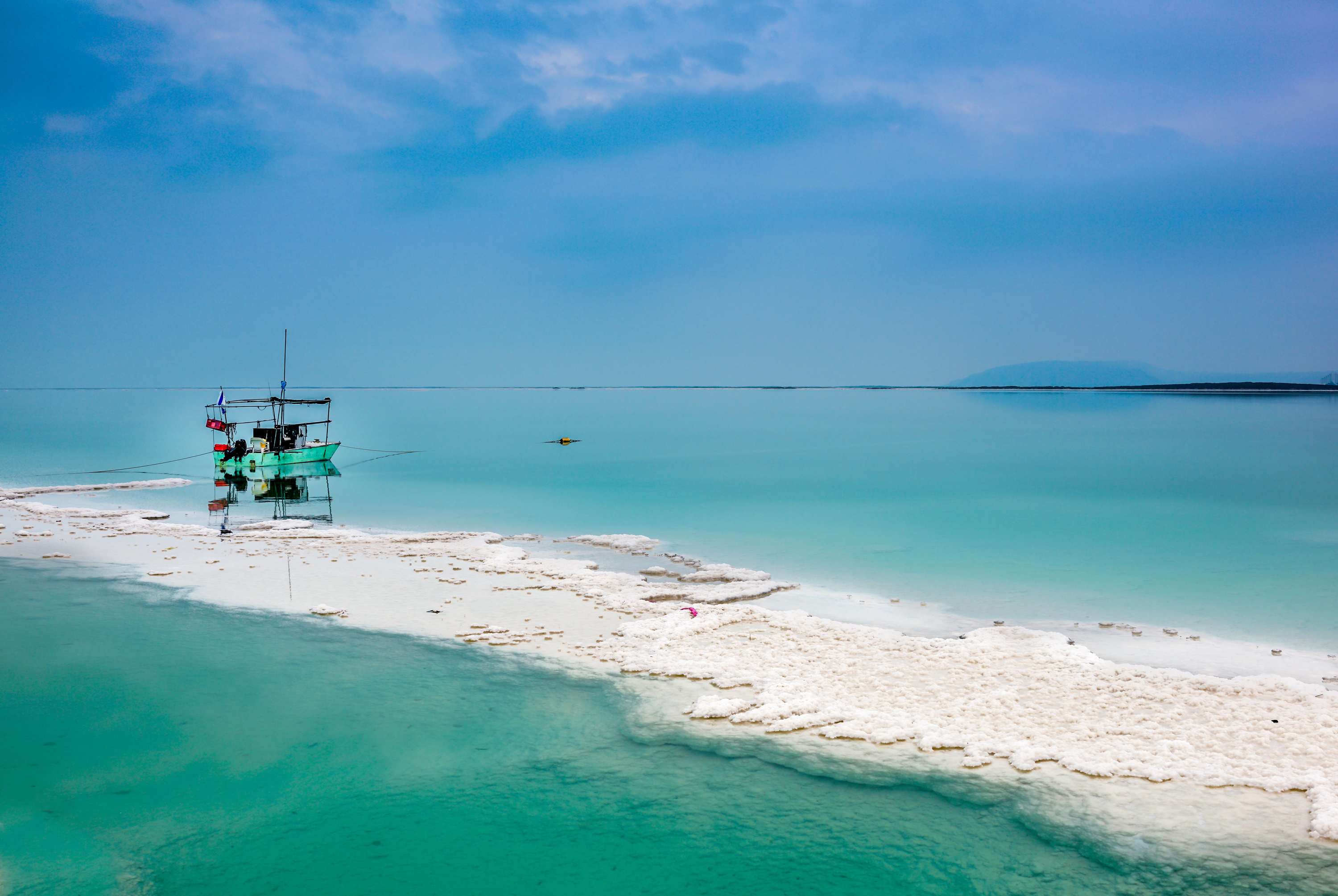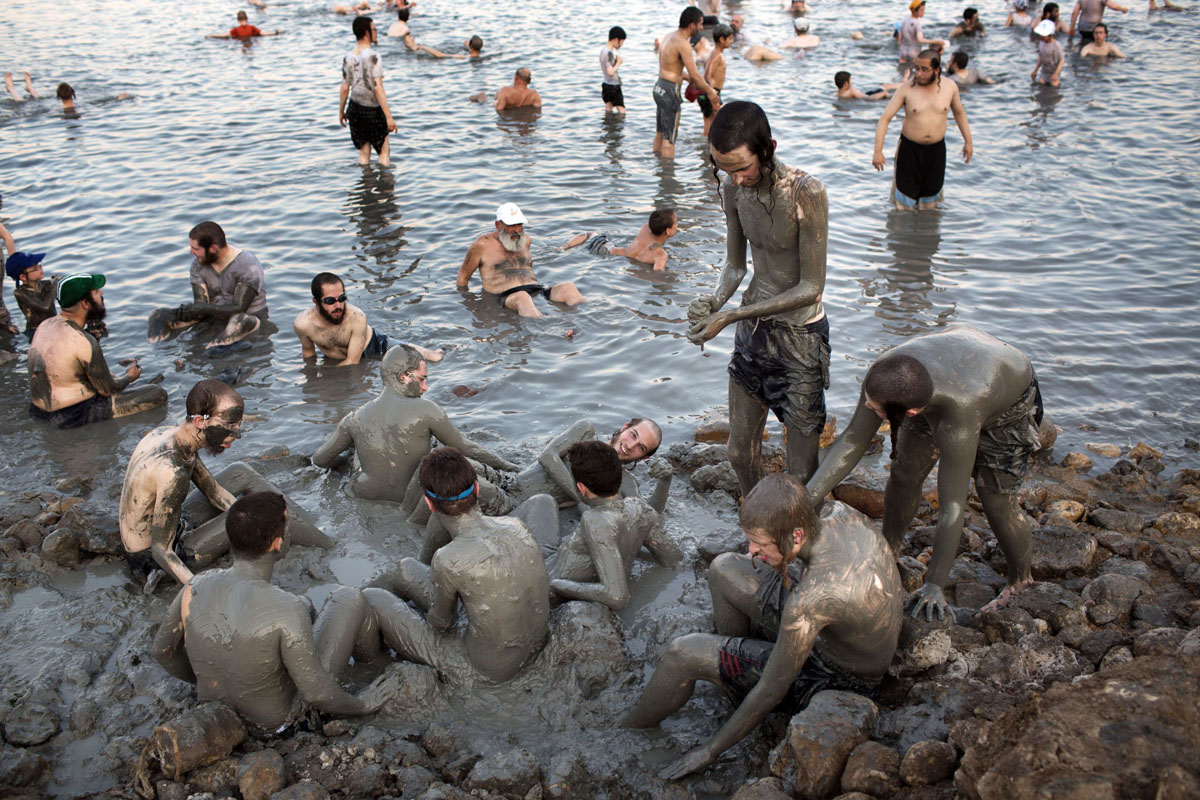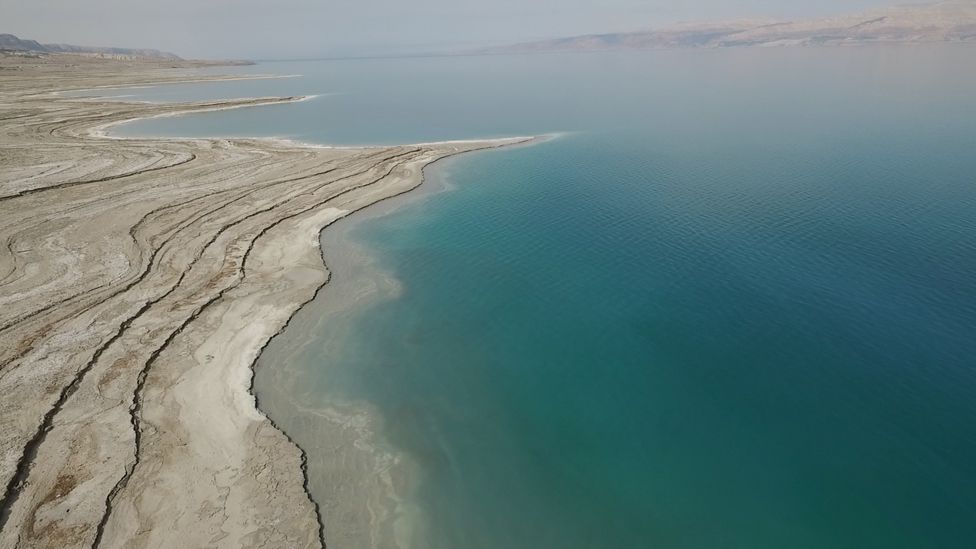

The Dead Sea holds a few world records of which one is being the lowest point on Earth. As for the degree of salinity, it is located among the four saltiest bodies of water in the world. Those special conditions are an outcome of its extreme geo-morphological structure, alongside a harsh desert climate. These create an environment of constant dramatic changes forming a breathtaking landscape, unique and different from any other in the world.

The Dead Sea is actually a huge lake, located in the heart of the Turkish-African Great Rift between Jordan and Israel. Its length is about 50 kilometers and the average width is 15 kilometers. It was formerly divided into two basins, with the North and South separated by the Lisan (Arabic for ‘Tongue’) peninsula. Since the late 70’s, the surface severely dropped and the Southern basin has dried out. The sea is presently confined to the Northern basin. The surface elevation is now 437m below sea level, and its depth is around 380m. A high salinity of around 34% allows no life in the water, although several scientists recently-discovered microorganisms that do survive the outstanding osmotic pressures. The sea is an abundant resource of various precious minerals and millions of tons of potassium, magnesium and bromide are manufactured annually to be marketed around the world.
Continent shields are in constant move. Mighty forces push some apart, pressing others against each other. The Dead Sea valley is a fraction of The Great Rift: a fault of some 37,000 miles that was created around 25 million years ago, as an outcome of an asymmetric shift between the Asian and the African shields. The Asian shield is shifting northbound about 1cm a year. The rapid movement forces frequent earthquakes along the rift. The fault’s axis’ angles produce an altering opening of ‘holes’ between the two shields. Among those are the “Akaba bay”, the “Dead Sea”, the “Sea of Galilee”, and the “Hula Valley”. Here, around the Dead Sea area, enormous rock layers sank into the magma. Alongside the horizontal shift there’s also a vertical rise. Thus, the lowest exposed place on Earth is 437m below sea level, and lays next to huge cliffs that tower to an elevation of 1750m.
The deep and steep Rift was filled with water some 3 million years ago, as a result of massive floods caused by the rise of the Mediterranean Sea level. A 320 km- long basin covered the rift from the “Hula Valley” until almost 80 miles south to where the Dead Sea is today.
An elevation of a new anticline at the heart of the “Jessereel Valley” blocked this channel around 2 million years ago, and formed a prolonged lake of 320 km. Its isolation and limited rains led to a constant drop of the surface. Sedimentation of various minerals pushed the salt up, gradually raising its salinity. While water was constantly evaporating, all salt remained locked in the basin. The percentage of salt has exceeded the bearing ability of the water, and tons of salt crystallized into large masses have sunk to the bottom, creating miles high layers of salt beneath the sea. 60,000 years ago, the Dead Sea finally reached its contemporary shape. The deep and narrow form exposed it to significant fluctuations of level. Around 25,000 years ago, due to dramatic rainy millennia, the level rose to more than 100m above the contemporary one. Around 8,000 BC, the level was more or less stabilized to the one we know today.
The Dead Sea is located in the middle of the Judean desert. During the summer the temperature rises to over 40ºc and may remain above 20ºc (daytime) throughout the winter. The air is constantly dry, and the average precipitation is less than 2 inch a year. The massive evaporation does not affect the immediate surroundings, but creates a visible constant mist hovering some 300m above the surface. On top of the other medical virtues of the Dead Sea, the high barometric pressure and the mist are perfect filters of UV radiation, attracting tourists from the whole world to sunbathe safely as an effective treatment of several skin diseases.
One of the unique attributes of the Dead Sea shores is them being a part of a ‘Rain-shed Desert’ – a unique phenomenon. Desert conditions reach some 130 kilometers north to the global latitude of the desert stripe, only a few miles east of the green, relatively rich in precipitation area around the Judean Mountains. The latter are drained towards the Mediterranean westbound, but the underground water stream towards the Dead Sea, forming long stripes of fresh water springs which allow many oases to develop in the midst of the harsh desert – a belt of thriving life brimming near the Dead Sea.
The 20th century has brought an overwhelming growth of population to the Middle East alongside modern technologies. These allowed the locals to utterly seize the water resources, which until modern era kept on feeding the Dead Sea, stabilizing its surface level. The main source was of course the River Jordan which solely supplied a billion cubic meters a year. An additional contribution was the numerous rivers which flow directly to the sea, especially from the East. But these were brutally cut off starting from the mid 60’s. Two dams block all the outgoing fresh water from the Sea of Galilee, designated from 1965 for national Israeli consumption. The water of the “Yarmuch”, merging into the Jordan from the Jordanian-Syrian border was channeled at the same year to the Eastern side of the Jordan Valley. The rest of the rivers were gradually captured, today allowing the flow only of water from sulfur springs and waste water that sum up to less than 5% of the original flow, assisted by rare flash-flood water, and local drizzle, altogether a trifle donation, in comparison to the massive evaporation. All these led to a gradual receding of 10-20 inch per year.
The Dead Sea Works Company had introduced the sea to a fierce reality since the end of the 1970s. Formerly, the Southern shallow basin was used for deliberate evaporation of the water as the primal process in production of the precious minerals. Since the surface dropped to cut off the two basins from each other, the Dead Sea Works started to pump water from the Northern basin and completely dried the southern one. The excessive exploitation of the sea causes a horrific drop of a meter every year, an interference that shutters the eco-system and brings about severe outcomes.
The combination of the drop in sea level alongside the prodigious flow of spring-water near the shores creates some interesting phenomena. The rocks circling the Dead Sea are mainly sedimentation of the previous phases of it, and contain mainly aragonite, gypsum and of course, remarkable amounts of salt. Some of the salt is set in huge underground boulders. As long as the surface is kept high, the condensed brine that intrudes the quick rock stabilizes the underground salt crystals. With the drop of the surface the underground level drops as well, leaving the underground salt crystals exposed to fresh water. After several rainy seasons and the assistance of the constant flowing springs, the underground salt-boulders dissolve, leaving underground cavities named which tend to collapse occasionally in various spots around the Dead Sea.
The first incident occurred in 1981. A bus was parked awaiting hikers near Ein Bokek when a 25m sink hole had opened abruptly under one of its wheels. A few other cases involved injuries of several victims. A comprehensive survey held in the late 1990s led to closing down of the Bungalow Resort, the Navy base and a palm plantation near Ein Gedi, and basically required canceling of all progress plans around the sea. Today, the phenomenon is highly surveilled and under control. Beneath several roads, wooden fortification constructions were set, and huge ramps were built next to holiday resorts, all done to assure the welfare and safety of the visitors.
The Dead Sea area has become a location for health research and potential treatment for several reasons. The mineral content of the water, the low content of pollens and other allergens in the atmosphere, the reduced ultraviolet component of solar radiation, and the higher atmospheric pressure at this great depth each may have specific health effects. For example, persons experiencing reduced respiratory function from diseases such as cystic fibrosis seem to benefit from the increased atmospheric pressure

The region's climate and low elevation have made it a popular center
for assessment of putative therapies:
- Climatotherapy : Treatment which exploits local climatic features such as temperature,
humidity, sunshine, barometric pressure and special atmospheric constituents
- Heliotherapy : Treatment that exploits the biological effects of the sun's radiation
- Thalassotherapy : Treatment that exploits bathing in Dead Sea water
Climatotherapy at the Dead Sea may be a therapy for psoriasis by sunbathing for long periods in the area due to its position below sea level and subsequent result that UV rays are partially blocked by the increased cloud cover over the Dead Sea
Rhinosinusitis patients receiving Dead Sea saline nasal irrigation exhibited improved symptom relief compared to standard hypertonic saline spray in one study
Dead Sea mud pack therapy has been suggested to temporarily relieve pain in patients with osteoarthritis of the knees. According to researchers of the Ben Gurion University of the Negev, treatment with mineral-rich mud compresses can be used to augment conventional medical therapy
Dwelling in caves near the Dead Sea is recorded in the Hebrew Bible as having
taken place before the Israelites came to Canaan, and extensively at the
time of King David. show more!
Aristotle wrote about the remarkable waters. The Nabateans and others discovered the value of
the globs of natural asphalt that constantly floated to the surface where they could be
harvested with nets. The Egyptians were steady customers, as they used asphalt in the
embalming process that created mummies. The Ancient Romans knew the Dead Sea as "Palus
Asphaltites" (Asphalt Lake) show more!
Intimately connected with the Judean wilderness to its northwest and west, the Dead Sea was a place of escape and refuge. The remoteness of the region attracted Greek Orthodox monks since the Byzantine era. Their monasteries, such as Saint George in Wadi Kelt and Mar Saba in the Judaean Desert, are places of pilgrimage.
In the 19th century the River Jordan and the Dead Sea were explored by boat primarily by
Christopher Costigan in 1835, Thomas Howard Molyneux in 1847, William Francis Lynch in
1848, and John MacGregor in 1869. The full text of W. F. Lynch's 1949 book Narrative of
the United States' Expedition to the River Jordan and the Dead Sea is available online.
Charles Leonard Irby and James Mangles travelled along the shores of the Dead Sea already
in 1817-18, but didn't navigate on its waters.
Explorers and scientists arrived in the
area to analyze the minerals and research the unique climate.
The sunset touching distant hills with ribbons of fire across the waters of the Dead Sea brings a sense of unreality to culminate a day’s visit to the lowest point on earth, some 400 meters below sea level. To reach this unique spot the visitor enjoys

A golf course named for Sodom and Gomorrah was built by the British at Kalia on the northern shore.
The first major Israeli hotels were built in nearby Arad, and since the 1960s at the Ein Bokek resort complex
Israel has 15 hotels along the Dead Sea shore, generating total revenues of $291 million in 2012. Most Israeli hotels and resorts on the Dead Sea are on a six-kilometre (3.7-mile) stretch of the southern shore
On the Jordanian side, nine international franchises have opened seaside resort hotels near the King Hussein Bin Talal Convention Center, along with resort apartments, on the eastern shore of the Dead Sea. The 9 hotels have boosted the Jordanian side's capacity to 2,800 rooms.
On November 22, 2015, the Dead Sea panorama road was included along with 40 archaeological locations in Jordan, to become live on Google Street View
The Palestinian Dead Sea Coast is about 40 kilometres (25 miles) long. The World Bank estimates that a Palestinian Dead Sea tourism industry could generate $290 million of revenues per year and 2,900 jobs
The surface level of the Dead Sea is falling by more than a metre a year
The Dead Sea, the salty lake located at the lowest point on Earth, is gradually shrinking under the heat of the Middle Eastern sun. For those who live on its shores it's a slow-motion crisis - but finding extra water to sustain the sea will be a huge challenge.
read more
